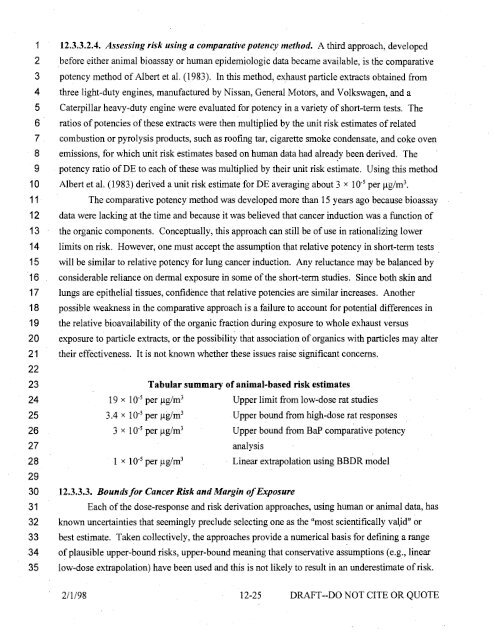Health Assessment Document for Diesel Emissions - NSCEP | US ...
Health Assessment Document for Diesel Emissions - NSCEP | US ...
Health Assessment Document for Diesel Emissions - NSCEP | US ...
Create successful ePaper yourself
Turn your PDF publications into a flip-book with our unique Google optimized e-Paper software.
1 12.3.3.2.4. Assessing risk using a comparative potency method. A third approach, developed<br />
2 be<strong>for</strong>e either animal bioassay or human epidemiologic data became available, is the comparative<br />
3 potency method of Albert et al. (1983). In this method, exhaust particle extracts obtained from<br />
4 three light-duty engines, manufactured by Nissan, General Motors, and Volkswagen, and a<br />
5 Caterpillar heavy-duty engine were evaluated <strong>for</strong> potency in a variety of short-term tests. The<br />
6 ratios of potencies of these extracts were then multiplied by the unit risk estimates of related<br />
7 combustion or pyrolysis products, such as roofing tar, cigarette smoke condensate, and coke oven<br />
8 emissions, <strong>for</strong> which unit risk estimates based on human data had already been derived. The<br />
9 potency ratio of DE to each of these was multiplied by their unit risk estimate. Using this method<br />
10 Albert et al. (1983) derived a unit risk estimate <strong>for</strong> DE averaging about J x 1 o- 5 per Jlglm 3 •<br />
11 The comparative potency method was developed more than 15 years ago because bioassay<br />
12 data were lacking at the time and because it was believed that cancer induction was a function of<br />
13 the organic components. Conceptually, this approach can still be of use in rationalizing lower<br />
14 limits on risk. However, one must accept the assumption that relative potency in short-term tests<br />
15 will be similar to relative potency <strong>for</strong> lung cancer induction. Any reluctance may be balanced by<br />
16 considerable reliance on dermal exposure in some of the short-term studies. Since both skin and<br />
17 lungs are epithelial tissues, confidence that relative potencies are similar increases. Another<br />
18 possible weakness in the comparative approach is a failure to account <strong>for</strong> potential differences in<br />
19 the relative bioavailability of the organic fraction during exposure to whole exhaust versus<br />
20 exposure to particle extracts, or the possibility that association of organics with particles may alter<br />
21 their effectiveness. It is not known whether these issues raise significant concerns.<br />
22<br />
23<br />
Tabular summary of animal-based risk estimates<br />
24<br />
19 X 1 o-<br />
25<br />
26<br />
27<br />
28<br />
29<br />
5 per J.lg/m3 Upper limit from low-dose rat studies<br />
3.4 x 10· 5 per J.lg;/m3 Upper bound from high-dose rat responses<br />
3 X 1 Q- 5 per J.lg/m3 Upper bound from BaP comparative potency<br />
analysis<br />
1 X 1 Q-5 per J.lg/m3 Linear extrapolation using BBDR model<br />
30 12.3.3.3. Bounds <strong>for</strong> Cancer Risk and Margin of Exposure<br />
31 Each of the dose-response and risk derivation approaches, using human or animal data, has<br />
32 known uncertainties that seemingly preclude selecting one as the "most scientifically va\id" or<br />
33 best estimate. Taken collectively, the approaches provide a numerical basis <strong>for</strong> defining a range<br />
34 of plausible upper-bound risks, upper-bound meaning that conservative assumptions (e.g., linear<br />
35 low-dose extrapolation) have been used and this is not likely to result in an underestimate of risk.<br />
2/1/98 12-25 DRAFT--DO NOT CITE OR QUOTE















